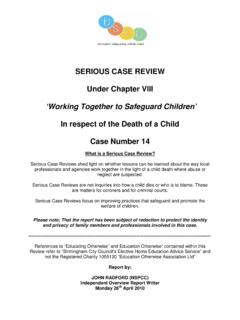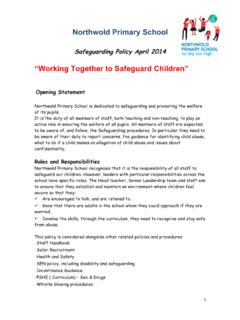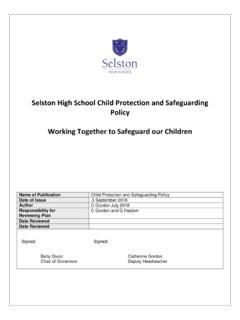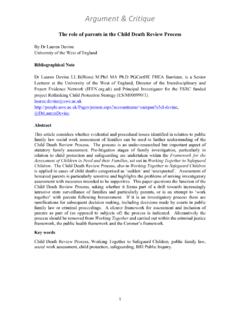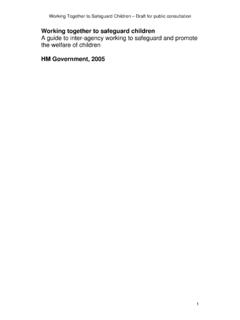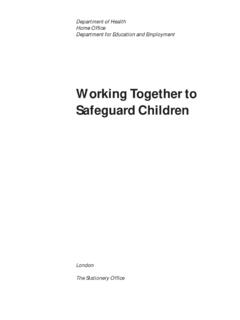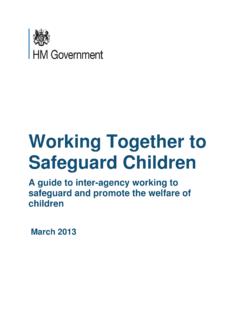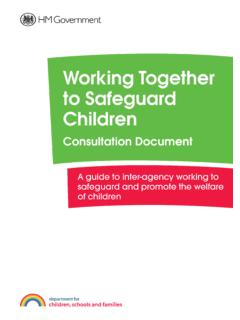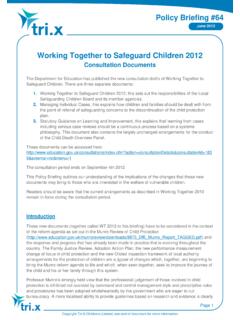Transcription of Working together to safeguard children - Rainbow Day Nursery
1 Working together to safeguard children England and Wales Safeguarding and promoting the welfare of children , for the sake of this policy is defined as: Protecting children from maltreatment Preventing the impairment of children s health or development Ensuring that children are growing up in circumstances consistent with the provision of safe and effective care. (Definition taken from the HM Government document Working together to safeguard children ) We support the children within our care, protect them from maltreatment and have robust procedures in place to prevent the impairment of children s health and development.
2 Safeguarding is a much wider subject than the elements covered within this single child protection policy, therefore this document should be used in conjunction with the other Nursery policies and procedures. Our Nursery will work with children , parents, external agencies and the community to ensure the welfare and safety of children and to give them the very best start in life. children have the right to be treated with respect and to be safe from any abuse in whatever form. To this end we will: Create an environment to encourage children to develop a positive self-image Encourage children to develop a sense of independence and autonomy in a way that is appropriate to their age and stage of development Provide a safe and secure environment for all children Always listen to children .
3 Rainbow Day Nursery has a clear commitment to protecting children and promoting welfare. Should anyone believe that this policy is not being upheld, it is their duty to report the matter to the attention of the Melissa Murfet / Emma Few at the earliest opportunity. The legal framework for this policy is based on: Safeguarding Vulnerable Groups Act (2006) Practitioners have a duty to protect and promote the welfare of children . Due to the many hours of care we are providing, staff will often be the first people to sense that there is a problem.
4 They may well be the first people in whom children confide about abuse. The Nursery has a duty to be aware that abuse does occur in our society. This statement lays out the procedures that will be followed if we have any reason to believe that a child in our care is subject to welfare issues including physical, sexual, emotional abuse or neglect. Our prime responsibility is the welfare and well-being of all children in our care. As such we believe we have a duty to the children , parents and staff to act quickly and responsibly in any instance that may come to our attention.
5 All staff will work as part of a multi-agency team where needed in the best interests of the child. The Nursery aims to: Ensure that children are never placed at risk while in the charge of Nursery staff Ensure that confidentiality is maintained at all times Ensure that all staff are alert to the signs of abuse, understand what is meant by child protection and are aware of the different ways in which children can be harmed including by other children bullying, discriminatory behaviour Ensure that all staff are familiar and updated regularly with child protection issues and procedures Ensure parents are fully aware of child protection policies and procedures when they register with the Nursery and kept informed of all updates when they occur Keep the child at the centre of all we do Regularly review and update this policy with staff and parents where appropriate.
6 children will be supported by offering reassurance, comfort and sensitive interactions. Activities will be devised according to individual circumstances to enable children to develop confidence within their peer group. Contact telephone numbers Ofsted 0845 601 4772 Local Safeguarding children s Board Local Authority social services 0345 045 5203 Local Authority Designated Officer 01223 714 760 Types of abuse Abuse and neglect are forms of maltreatment of a child. Somebody may abuse or neglect a child by harming them, or by failing to act to prevent harm.
7 children may be abused within a family, institution, or community setting by those known to them or a stranger. This could be an adult or adults, another child or children . The signs and indicators listed below may not necessarily indicate that a child has been abused, but will help us to recognise that something may be wrong, especially if a child shows a number of these symptoms or any of them to a marked degree. Physical abuse Action needs to be taken if staff have reason to believe that there has been a physical injury to a child, including deliberate poisoning; where there is definite knowledge, or reasonable suspicion that the injury was inflicted or knowingly not prevented.
8 These symptoms may include bruising or injuries in an area that is not usual for a child, fleshy parts of the arms and legs, back, wrists, ankles and face. Many children will have cuts and grazes from normal childhood injuries these should also be logged and discussed with the Nursery manager or room leader. children and babies may be abused physically through shaking or throwing. Other injuries may include burns or scalds. These are not usual childhood injuries and should always be logged and discussed with the Nursery manager Procedure.
9 All signs of marks/injuries to a child, when they come into Nursery or occur during time at the Nursery , will be recorded as soon as noticed by a staff member The incident will be discussed with the parent at the earliest opportunity Such discussions will be recorded and the parent will have access to such records If there appear to be any queries regarding the injury, the Local Safeguarding children s Board (LSCB) in the local authority will be notified. Fabricated illness This is also a type of physical abuse.
10 This is where a child is presented with an illness that is fabricated by the adult carer. The carer may seek out unnecessary medical treatment or investigation. The signs may include a carer exaggerating a real illness or symptoms, complete fabrication of symptoms or inducing physical illness through poisoning, starvation, inappropriate diet. This may also be presented through false allegations of abuse or encouraging the child to appear disabled or ill to obtain unnecessary treatment or specialist support.
